Tracking Urban Expansion Using Random Forests for the Classification of Landsat Imagery (1986–2015) and Predicting Urban/Built-Up Areas for 2025: A Study of the Kumasi Metropolis, Ghana
Abstract
1. Introduction
2. Materials and Methods
2.1. Study Area
2.2. Satellite Image Processing and Classification
2.3. Accuracy Assessment
2.4. Urban Land Modeling and Validation
- i
- ‘Hits’ meant the changes in the predicted model were correct.
- ii
- ‘False alarms’ signified the model predicted changes but remained unchanged.
- iii
- ‘Misses’ indicated the model predicted no changes, but changes occurred.
- iv
- ‘Null success’ meant the model predicted no changes and remained stable.
2.5. Urban Expansion Analysis
2.6. Density of Urban Expansion
Correlation between Density of Urban Expansion and Distance to the Main Road
- r = Correlation coefficient
- X = Distance to the main road (Kumasi–Accra road)
- Y = Density of Urban Expansion
- N = total buffers
2.7. Software Used
3. Results
3.1. General Description and LULC Distribution
3.2. Nature of LULC Changes
3.3. Tabulation of LULC Changes
3.4. Accuracy Assessment
3.5. LULCC Models and Validation
3.6. Validated and Projected Maps
3.7. Areal Extent of each LULC in 2025
3.8. Urban Expansion Analysis
3.9. Urban Expansion in the Sub-Metropolitan Zones
3.10. Urban Extent in each Sub-Metropolitan Area in Kumasi
3.11. Urban Expansion along a Major Road
3.12. Urban Expansion in the 400 Meters Buffer
3.13. Density of Urban Expansion
3.14. Density Decay Curve
- y = density of urban expansion
- x = distance to a major road
3.15. Correlation between Density of Urban Expansion and Distance to the Kumasi–Accra Road
4. Discussion
4.1. Image Classification and Accuracy Assessment
4.2. Land Use Land Cover Changes
4.3. Causes of LULC Changes
4.4. Urban Expansion in Kumasi
4.5. Effects of Urban Expansion
5. Conclusions
Author Contributions
Funding
Institutional Review Board Statement
Informed Consent Statement
Data Availability Statement
Acknowledgments
Conflicts of Interest
Appendix A. User and Producer Accuracies for the Classified Satellite Images
| LULC | Urban/Built-Up | Agricultural Lands | Forestlands | Total | User Accuracy | Kappa |
|---|---|---|---|---|---|---|
| Urban/built-up | 50 | 0 | 0 | 50 | 1 | 0 |
| Agricultural lands | 8 | 42 | 0 | 50 | 0.84 | 0 |
| Forestlands | 6 | 0 | 44 | 50 | 0.88 | 0 |
| Total | 64 | 42 | 44 | 150 | 0 | 0 |
| Producer Accuracy | 0.78 | 1 | 1 | 0 | 0.91 | 0 |
| Kappa | 0 | 0 | 0 | 0 | 0 | 0.86 |
| LULC | Urban/ Built-Up | Agricultural Lands | Forestlands | Total | User Accuracy | Kappa |
|---|---|---|---|---|---|---|
| Urban/built-up | 50 | 0 | 0 | 50 | 1 | 0 |
| Agricultural lands | 0 | 50 | 0 | 50 | 1 | 0 |
| Forestlands | 1 | 3 | 46 | 50 | 0.92 | 0 |
| Total | 51 | 53 | 46 | 150 | 0 | 0 |
| Producer Accuracy | 0.98 | 0.94 | 1 | 0 | 0.97 | 0 |
| Kappa | 0 | 0 | 0 | 0 | 0 | 0.96 |
| LULC | Urban/ Built-Up | Agricultural Lands | Forestlands | Total | User Accuracy | Kappa |
|---|---|---|---|---|---|---|
| Urban/built-up | 50 | 0 | 0 | 50 | 1 | 0 |
| Agricultural lands | 2 | 48 | 0 | 50 | 0.96 | 0 |
| Forestlands | 1 | 0 | 49 | 50 | 0.98 | 0 |
| Total | 53 | 48 | 49 | 150 | 0 | 0 |
| Producer Accuracy | 0.94 | 1 | 1 | 0 | 0.98 | 0 |
| Kappa | 0 | 0 | 0 | 0 | 0 | 0.97 |
Appendix B. Student t-test
References
- United Nations Department of Economic and Social Affairs—Population Division (UNDESA-PD). World Population Prospects 2019—Highlights; United Nations: New York, NY, USA, 2019.
- United Nations Department of Economic and Social Affairs—Population Division (UNDESA-PD). The 2018 Revision. In World Urbanization Prospects; United Nations: New York, NY, USA, 2019; Volume 12. [Google Scholar]
- Martine, G.; McGranahan, G.; Montgomery, M.; Fernández-Castilla, R. The New Global Frontier: Urbanization, Poverty and Environment in the 21st Century; Earthscan: London, UK, 2012. [Google Scholar]
- Moriconi-Ebrard, F.; Harre, D.; Heinings, P. Urbanisation Dynamics in West. Africa 1950–2010: Africapolis I, 2015 Update; West African Studies, OECD Publishing: Paris, France, 2016. [Google Scholar]
- Raddad, S.; Salleh, A.G.; Samat, N. Determinants of Agriculture Land Use Change in Palestinian Urban Environment: Urban Planners at Local Governments Perspective. Am. J. Sustain. Agric. 2010, 4, 30–38. [Google Scholar]
- Patino, J.E.; Duque, J.C. A Review of Regional Science Applications of Satellite Remote Sensing in Urban Settings. Comput. Environ. Urban. Syst. 2013, 37, 1–17. [Google Scholar] [CrossRef]
- Weeks, J.R. Population: An Introduction to Concepts and Issues, 10th ed.; Caldeira, C., Weeks, D., Beesley, T., Eds.; Thomson Wadsworth: Belmont, CA, USA, 2008. [Google Scholar]
- Laurance, W.F.; Sayer, J.; Cassman, K.G. Agricultural Expansion and Its Impacts on Tropical Nature. Trends Ecol. Evol. 2014, 29, 107–116. [Google Scholar] [CrossRef]
- Willcock, S.; Phillips, O.L.; Platts, P.J.; Swetnam, R.D.; Balmford, A.; Burgess, N.D.; Ahrends, A.; Bayliss, J.; Doggart, N.; Doody, K.; et al. Land Cover Change and Carbon Emissions over 100 Years in an African Biodiversity Hotspot. Glob. Chang. Biol. 2016, 22, 2787–2800. [Google Scholar] [CrossRef] [PubMed]
- Parnell, S.; Walawege, R. Sub-Saharan African Urbanisation and Global Environmental Change. Glob. Environ. Chang. 2011, 21, S12–S20. [Google Scholar] [CrossRef]
- Cohen, B. Urbanization in Developing Countries: Current Trends, Future Projections, and Key Challenges for Sustainability. Technol. Soc. 2006, 28, 63–80. [Google Scholar] [CrossRef]
- International Panel on Climate Change (IPCC). Climate Change 2001: Impacts, Adaptation, and Vulnerability. Choice Rev. Online 2001, 39, 3433.
- Ghana Statistical Service (GSS). 2010 Population & Housing Census National Analytical Report. Ghana Stat. Serv. 2013, 1, 1–91. [Google Scholar]
- Songsore, J. Towards a Better Understanding of Urban. Change: Urbanization, National Development and Inequality in Ghana; Ghana Universities Press: Accra, Ghana, 2003. [Google Scholar]
- Owusu, G. Small Towns in Ghana: Justifications for Their Promotion under Ghana’s Decentralisation Programme. Afr. Stud. Q. 2005, 8, 48–69. [Google Scholar]
- GSS. 2010 Population and Housing Census, Summary of Report of Final Results. Ghana Stat. Serv. 2012, 1, 1–117. [Google Scholar]
- Ghana Statistical Service (GSS). District Analytical Report. Kumasi Metropolitan; Sakoa Press Limited: Accra, Ghana, 2014. [Google Scholar]
- Japan International Cooperation Agency (JICA). The Study on the Comprehensive Urban. Development Plan. for Greater Kumasi in the Republic of Ghana—Final Report Summary; Japan International Cooperation Agency: Tokyo, Japan; Oriental Consultants Co., Ltd.: Tokyo, Japan; CTI Engineering International Co., Ltd.: Tokyo, Japan; ALMEC Corporation: Tokyo, Japan, 2013. [Google Scholar]
- Afrane, S.C.; Amoako, C. Peri-Urban development in Kumasi. In Future of the Tree: Towards Growth and Development of Kumasi; Adarkwa, K.K., Ed.; University Printing Press: Kumasi, Ghana, 2011; pp. 92–110. [Google Scholar]
- Abass, K.; Adanu, S.K.; Agyemang, S. Peri-Urbanisation and Loss of Arable Land in Kumasi Metropolis in Three Decades: Evidence from Remote Sensing Image Analysis. Land Use Policy 2018, 72, 470–479. [Google Scholar] [CrossRef]
- Afriyie, K.; Abass, K.; Adomako, J.A.A. Urbanisation of the Rural Landscape: Assessing the Effects in Peri-Urban Kumasi. Int. J. Urban. Sustain. Dev. 2014, 6, 1–19. [Google Scholar] [CrossRef]
- Araya, Y.H.; Cabral, P. Analysis and Modeling of Urban Land Cover Change in Setúbal and Sesimbra, Portugal. Remote Sens. 2010, 2, 1549–1563. [Google Scholar] [CrossRef]
- Frimpong, B.F. Land Use and Cover Changes in the Mampong Municipality of the Ashanti Region. Master’s Thesis, Department of Theoretical and Applied Biology, Kwame Nkrumah University of Science and Technology, Kumasi, Ghana, 2015. [Google Scholar]
- Vermeiren, K.; Van Rompaey, A.; Loopmans, M.; Serwajja, E.; Mukwaya, P. Urban Growth of Kampala, Uganda: Pattern Analysis and Scenario Development. Landsc. Urban. Plan. 2012, 106, 199–206. [Google Scholar] [CrossRef]
- Aduah, M.S.; Baffoe, P.E. Remote Sensing for Mapping Land-Use/Cover Changes and Urban Sprawl in Sekondi-Takoradi, Western Region of Ghana. Int. J. Eng. Sci. 2013, 2, 66–73. [Google Scholar]
- Schubert, H.; Calvo, A.C.; Rauchecker, M.; Rojas-Zamora, O.; Brokamp, G.; Schütt, B. Article Assessment of Land Cover Changes in the Hinterland of Barranquilla (Colombia) Using Landsat Imagery and Logistic Regression. Land 2018, 7, 152. [Google Scholar] [CrossRef]
- Ross, C.; Fildes, S.; Millington, A.C. Land-Use and Land-Cover Change in the Páramo of South-Central Ecuador, 1979–2014. Land 2017, 6, 46. [Google Scholar] [CrossRef]
- Taubenbock, H.; Esch, T. Remote Sensing—An Effective Data Source for Urban Monitoring. Available online: http://Earthzine.Org./2011/07/02/remote-sensing-an-effective-data-source-for-urban-monitoring/ (accessed on 9 November 2015).
- Subedi, P.; Subedi, K.; Thapa, B. Application of a Hybrid Cellular Automaton—Markov (CA-Markov) Model in Land-Use Change Prediction: A Case Study of Saddle Creek Drainage Basin, Florida. Appl. Ecol. Environ. Sci. 2013, 1, 126–132. [Google Scholar] [CrossRef]
- Attua, E.M.; Fisher, J.B. Historical and Future Land-Cover Change in a Municipality of Ghana. Earth Interact. 2011, 15, 1–26. [Google Scholar] [CrossRef]
- Addae, B.; Oppelt, N. Land-Use/Land-Cover Change Analysis and Urban Growth Modelling in the Greater Accra Metropolitan Area (GAMA), Ghana. Urban. Sci. 2019, 3, 26. [Google Scholar] [CrossRef]
- Yao, F.; Hao, C.; Zhang, J. Simulating Urban Growth Processes by Integrating Cellular Automata Model and Artificial Optimization in Binhai New Area of Tianjin, China. Geocarto Int. 2016, 31, 612–627. [Google Scholar] [CrossRef]
- Koranteng, A.; Zawia-nied, T. Monitoring of Deforestation in Kumasi Area (Ghana) by Satellite-Based Multi-Temporal Land Use Analysis Monitoring. Ann. Geomat. 2008, 6, 71–84. [Google Scholar]
- Wemegah, C.S.; Yamba, E.I.; Aryee, J.N.A.; Sam, F.; Amekudzi, L.K. Assessment of Urban Heat Island Warming in the Greater Accra Region. Sci. Afr. 2020, 8, e00426. [Google Scholar]
- Yeboah, F.; Awotwi, A.; Forkuo, E.K.; Kumi, M. Assessing Land Use and Land Cover Changes Due to Urban Growth in Accra. J. Basic Appl. Res. Int. 2017, 22, 43–50. [Google Scholar]
- Mensah, C.; Atayi, J.; Kabo-Bah, A.T.; Švik, M.; Acheampong, D.; Kyere-Boateng, R.; Prempeh, N.A.; Marek, M.V. Impact of Urban Land Cover Change on the Garden City Status and Land Surface Temperature of Kumasi. Cogent Environ. Sci. 2020, 6, 1787738. [Google Scholar] [CrossRef]
- Buo, I.; Sagris, V.; Burdun, I.; Uuemaa, E. Estimating the Expansion of Urban Areas and Urban Heat Islands (UHI) in Ghana: A Case Study. Nat. Hazards 2020. [Google Scholar] [CrossRef]
- Owusu, A.B. An Assessment of Urban Vegetation Abundance in Accra Metropolitan Area, Ghana: A Geospatial Approach. J. Environ. Geogr. 2018, 11, 37–44. [Google Scholar] [CrossRef]
- Koranteng, A. Competitive Land Use/Cover of Kumasi and Its Environs Based on Satellite Imagery Studies; ICAST: Orlando, FL, USA, 2014; pp. 208–219. [Google Scholar]
- Essel, B. Depletion of Urban Green Space and Its Adverse Effect: A Case of Kumasi, the Former Garden City of West—Africa. J. Environ. Ecol. 2017, 8, 1. [Google Scholar] [CrossRef]
- Mensah, C.A. Is Kumasi Still a Garden City? Land Use Analysis between 1980–2010. J. Environ. Ecol. 2014, 5, 89. [Google Scholar] [CrossRef]
- Koranteng, A.; Zawiła-Niedźwiecki, T.; Kombat, D. Land Use Dynamics in Rural-Urban Environs: A Study of the Kumasi Metropolis and Its Adjoining Districts—Ghana. Teledetekcja Sr. 2015, 52, 67–85. [Google Scholar]
- Abass, K.; Afriyie, K.; Abrafi Adomako, J.A. Household Responses to Livelihood Transformation in Peri-Urban Kumasi. J. Sustain. Dev. 2013, 6, 121–136. [Google Scholar] [CrossRef]
- Cobbinah, P.B.; Amoako, C. Urban Sprawl and the Loss of Peri-Urban Land in Kumasi, Ghana. Int. J. Soc. Hum. Sci. 2012, 6, 388–397. [Google Scholar]
- Nero, B.F.; Callo-Concha, D.; Anning, A.; Denich, M. Urban Green Spaces Enhance Climate Change Mitigation in Cities of the Global South: The Case of Kumasi, Ghana. Procedia Eng. 2017, 198, 69–83. [Google Scholar] [CrossRef]
- Asabere, S.B.; Acheampong, R.A.; Ashiagbor, G.; Beckers, S.C.; Keck, M.; Erasmi, S.; Schanze, J.; Sauer, D. Urbanization, Land Use Transformation and Spatio-Environmental Impacts: Analyses of Trends and Implications in Major Metropolitan Regions of Ghana. Land Use Policy 2020, 96, 104707. [Google Scholar] [CrossRef]
- Baboo, D.S.S.; Devi, M.R. An Analysis of Different Resampling Methods in Coimbatore, District. Glob. J. Comput. Sci. Technol. 2010, 10, 61–66. [Google Scholar]
- Anderson, J.R.; Hardy, E.E.; Roach, J.T.; Witmer, R.E. A Land Use and Land Cover Classification System for Use with Remote Sensor Data; A Revision of the Land Use Classification System as Presented in U.S. Geological Survey Circular 671; United States Government Printing Office: Washington, DC, USA, 1976; p. 964.
- Breiman, L. Random Forests. In Machine Learning; Academic Publishers: Cambridge, MA, USA, 2001; Volume 45, pp. 5–32. [Google Scholar]
- Shade, C.; Kremer, P. Predicting Land Use Changes in Philadelphia Following Green Infrastructure Policies. Land 2019, 8, 28. [Google Scholar] [CrossRef]
- Han, H.; Yang, C.; Song, J. Scenario Simulation and the Prediction of Land Use and Land Cover Change in Beijing, China. Sustainability 2015, 7, 4260–4279. [Google Scholar] [CrossRef]
- Pontius, R.G., Jr.; Chen, H. GEOMOD Modeling. In Idrisi 15: The Andes Edition; Clark University: Worcester, MA, USA, 2006; pp. 1–44. [Google Scholar]
- McLeod, S.; Schapper, J.H.M.; Curtis, C.; Graham, G. Conceptualizing Freight Generation for Transport and Land Use Planning: A Review and Synthesis of the Literature. Transp. Policy 2019, 74, 24–34. [Google Scholar] [CrossRef]
- Deng, J.S.; Wang, K.; Hong, Y.; Qi, J.G. Spatio-Temporal Dynamics and Evolution of Land Use Change and Landscape Pattern in Response to Rapid Urbanization. Landsc. Urban. Plan. 2009, 92, 187–198. [Google Scholar] [CrossRef]
- Kim, H.J. Spatiotemporal Pattern Analysis of Rapid Urban Expansion Using GIS and Remote Sensing. Int. J. Appl. Geospatial Res. 2010, 1, 55–70. [Google Scholar] [CrossRef]
- Stemn, E.; Agyapong, E. Assessment of Urban Expansion in the Sekondi-Takoradi Metropolis of Ghana Using Remote-Sensing and GIS Approach. Int. J. Sci. Technol. 2014, 3, 452–460. [Google Scholar]
- Eastman, J.R. TerrSet Tutorial; Clark Labs, Clark University: Worcester, MA, USA, 2016. [Google Scholar]
- Chan, J.C.W.; Paelinckx, D. Evaluation of Random Forest and Adaboost Tree-Based Ensemble Classification and Spectral Band Selection for Ecotope Mapping Using Airborne Hyperspectral Imagery. Remote Sens. Environ. 2008, 112, 2999–3011. [Google Scholar] [CrossRef]
- Shang, X.; Chisholm, L.A. Classification of Australian Native Forest Species Using Hyperspectral Remote Sensing and Machine-Learning Classification Algorithms. IEEE J. Sel. Top. Appl. Earth Obs. Remote Sens. 2014, 7, 2481–2489. [Google Scholar] [CrossRef]
- Skinner, M.W.; Kuhn, R.G.; Joseph, A.E. Agricultural Land Protection in China: A Case Study of Local Governance in Zhejiang Province. Land Use Policy 2001, 18, 329–340. [Google Scholar] [CrossRef]
- Cities Alliance. Future Proofing Cities Metropolitan Cities in Ghana; Arup: London, UK, 2016. [Google Scholar]
- Ghana Statistical Service (GSS). Urbanisation. 2010 Population & Housing Census Report; Sakora Press Limited: Accra, Ghana, 2014. [Google Scholar]
- Ministry of Environment, Science and Technology National Science, Technology and Innovation Policy; MESTI: Accra, Ghana, 2015.
- Asare, G.E. Kumasi: The Garden City without Gardens? Daily Graphic. Graphic Communications Group, Accra. pp. 40–41. Available online: http://graphic.com.gh/features/features/10748-kumasi-the-garden-city-without-gardens.html (accessed on 4 January 2021).
- Mensah, C.A. Destruction of Urban Green Spaces: A Problem Beyond Urbanization in Kumasi City (Ghana). Am. J. Environ. Prot. 2014, 3, 1. [Google Scholar] [CrossRef]
- Zhou, X.; Wang, Y.C. Spatial-Temporal Dynamics of Urban Green Space in Response to Rapid Urbanization and Greening Policies. Landsc. Urban. Plan. 2011, 100, 268–277. [Google Scholar] [CrossRef]
- Brueckner, J.K. U Rban S Prawl. Int. Reg. Sci. Rev. 2000, 23, 160–171. [Google Scholar] [CrossRef]
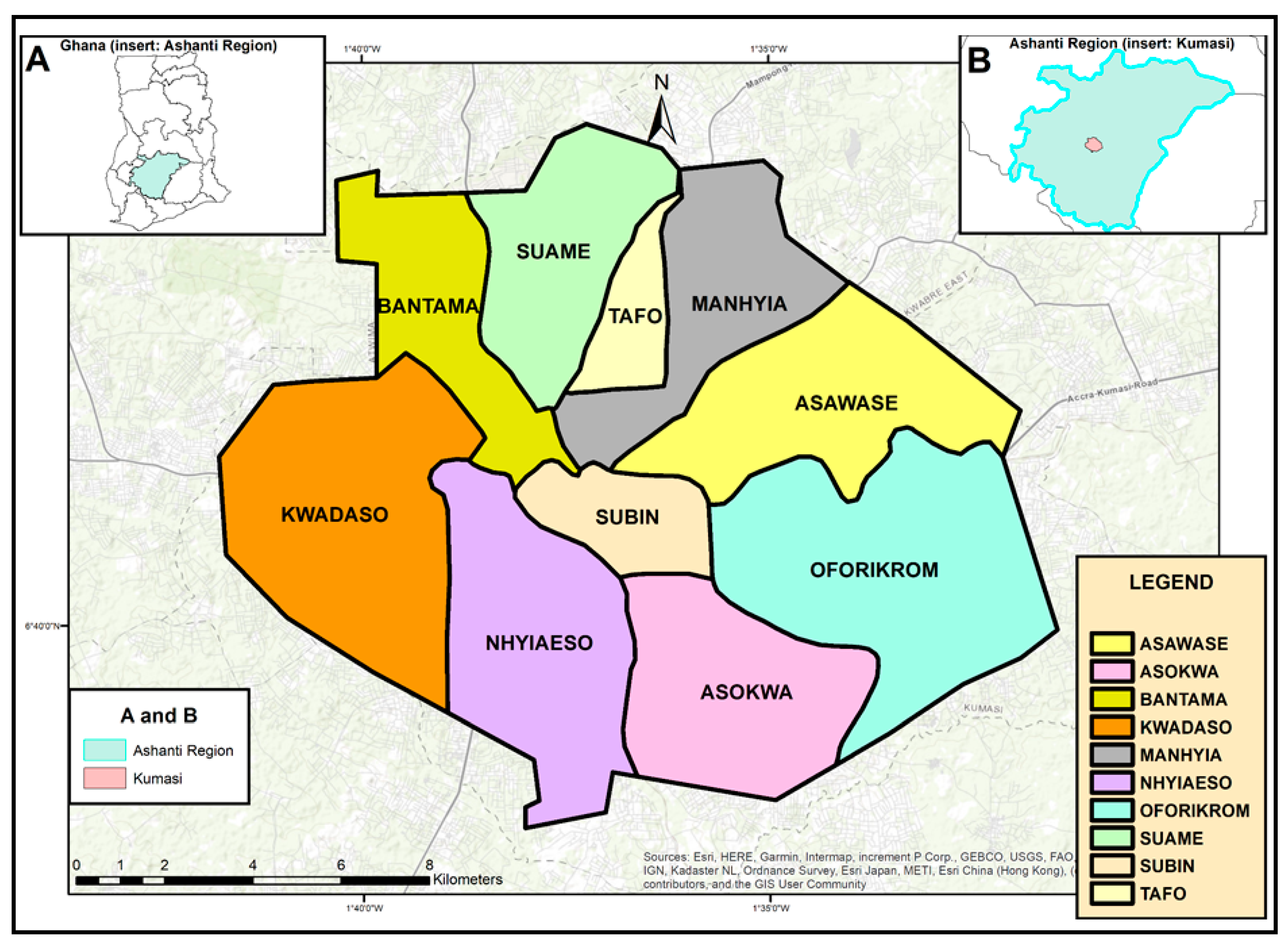
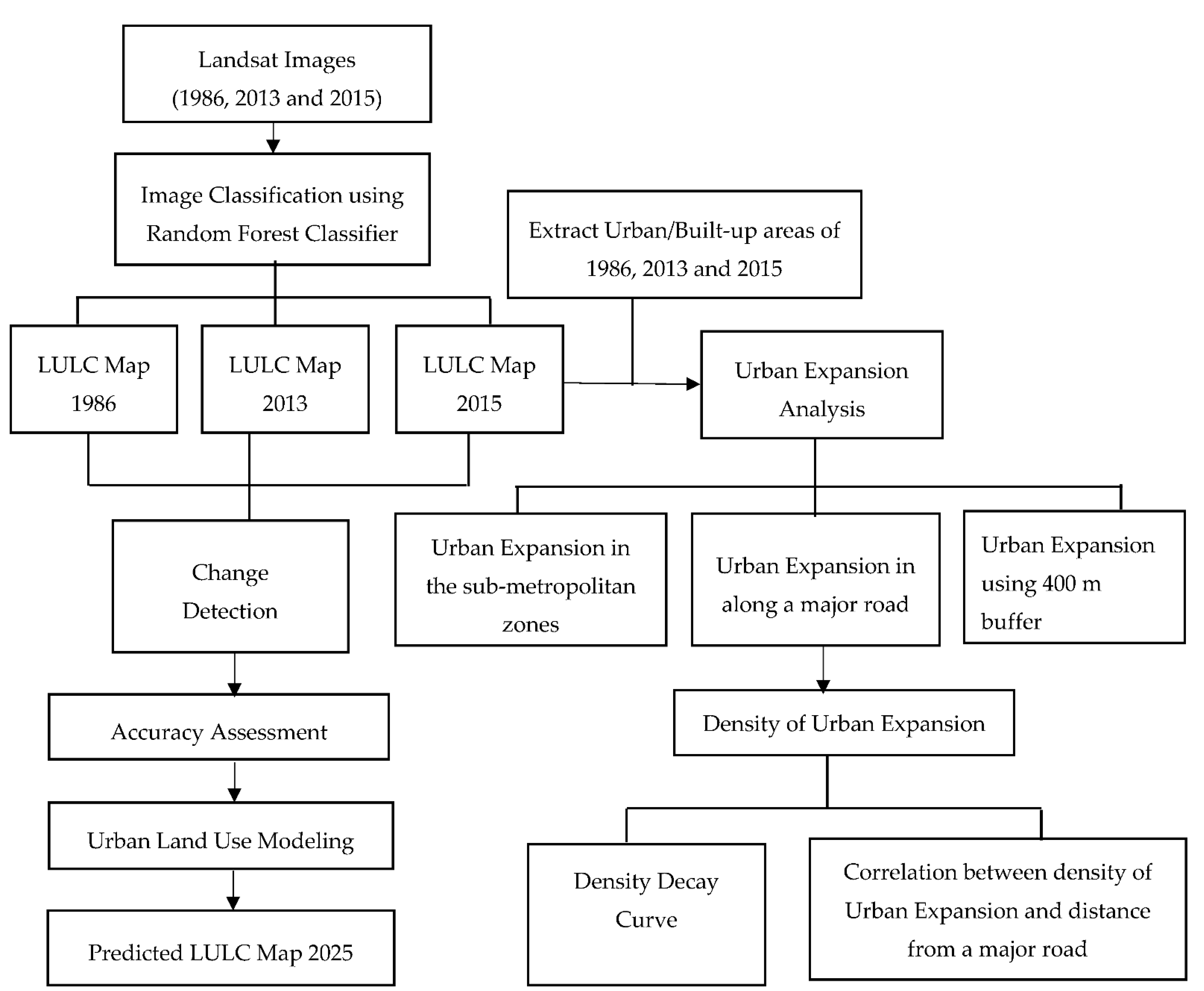
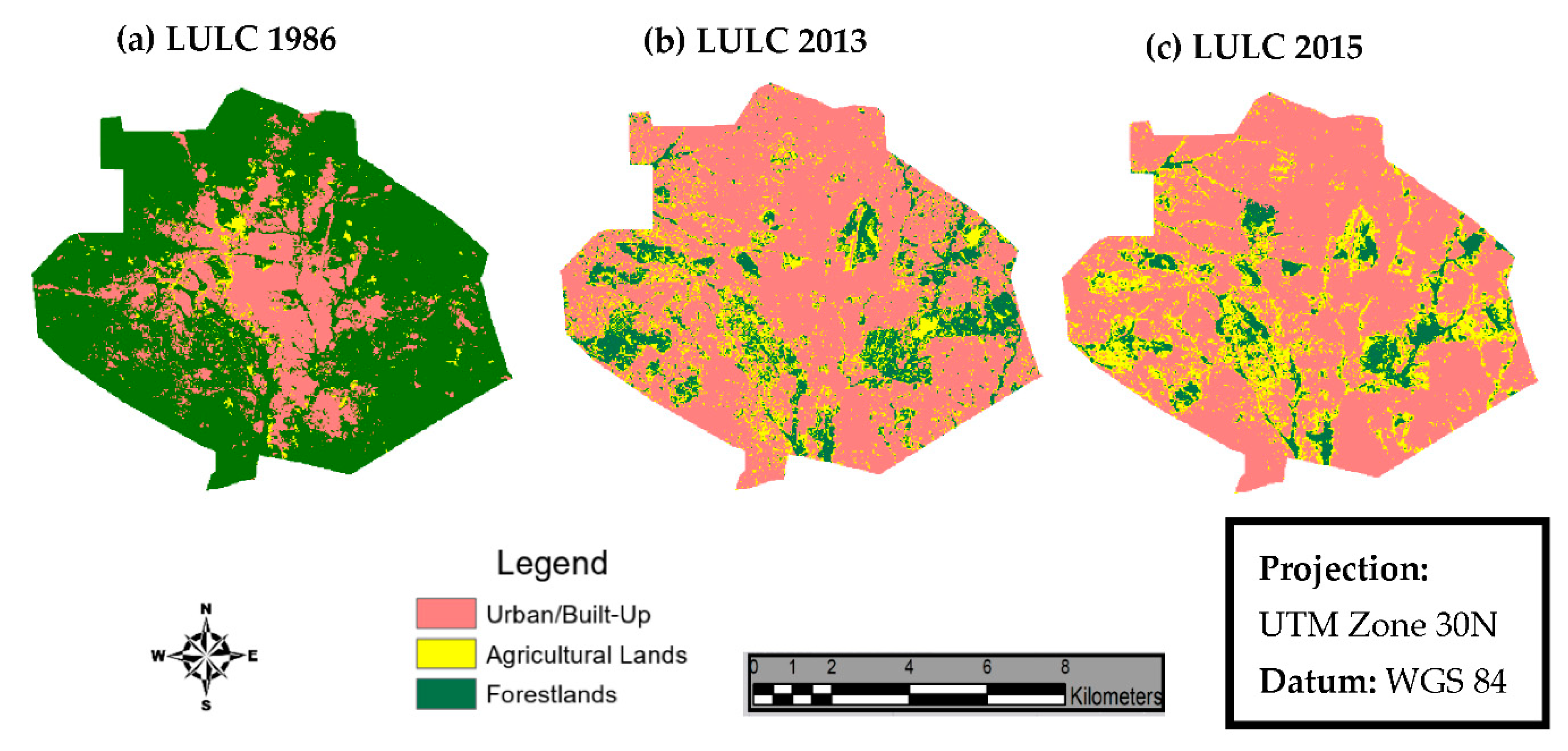
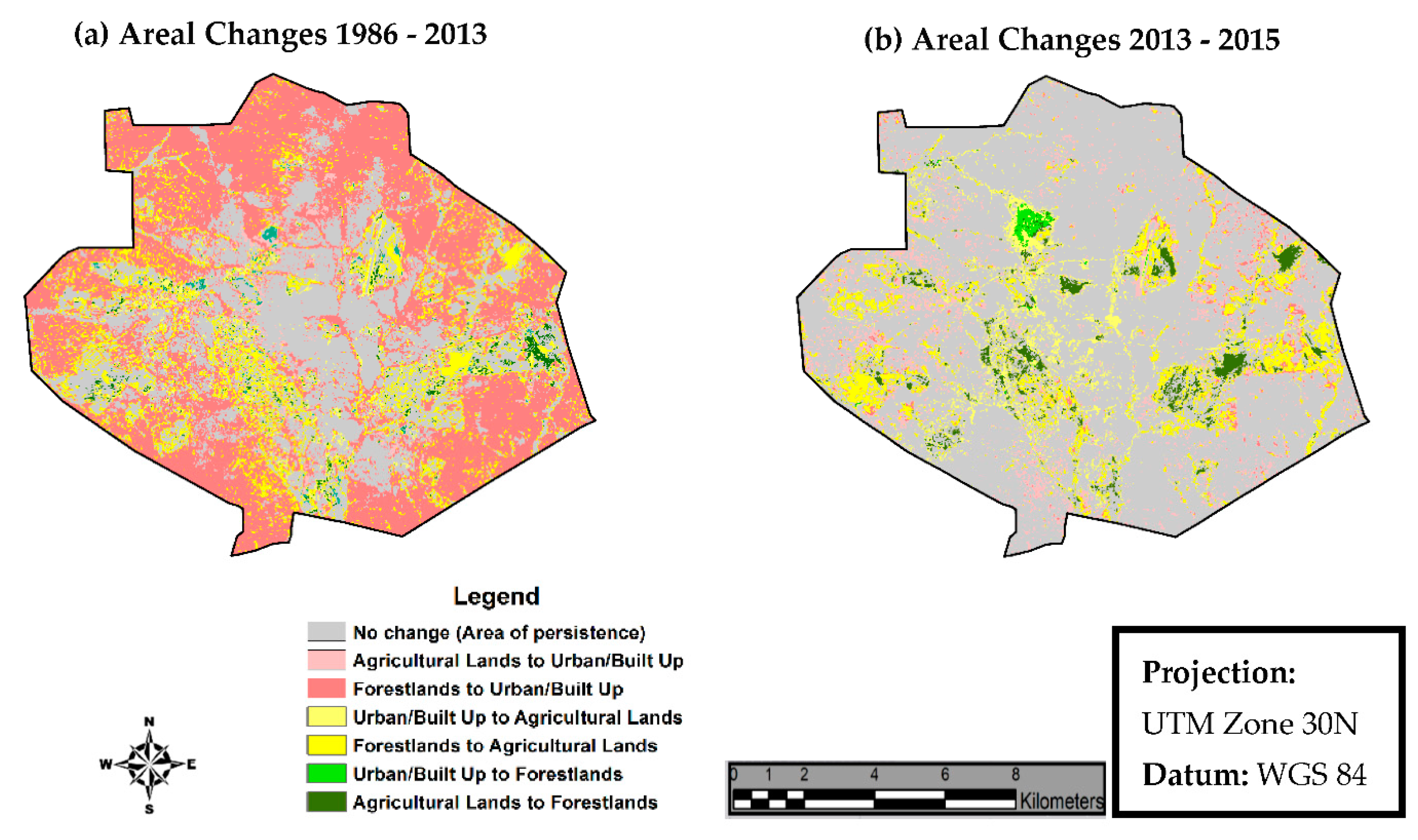
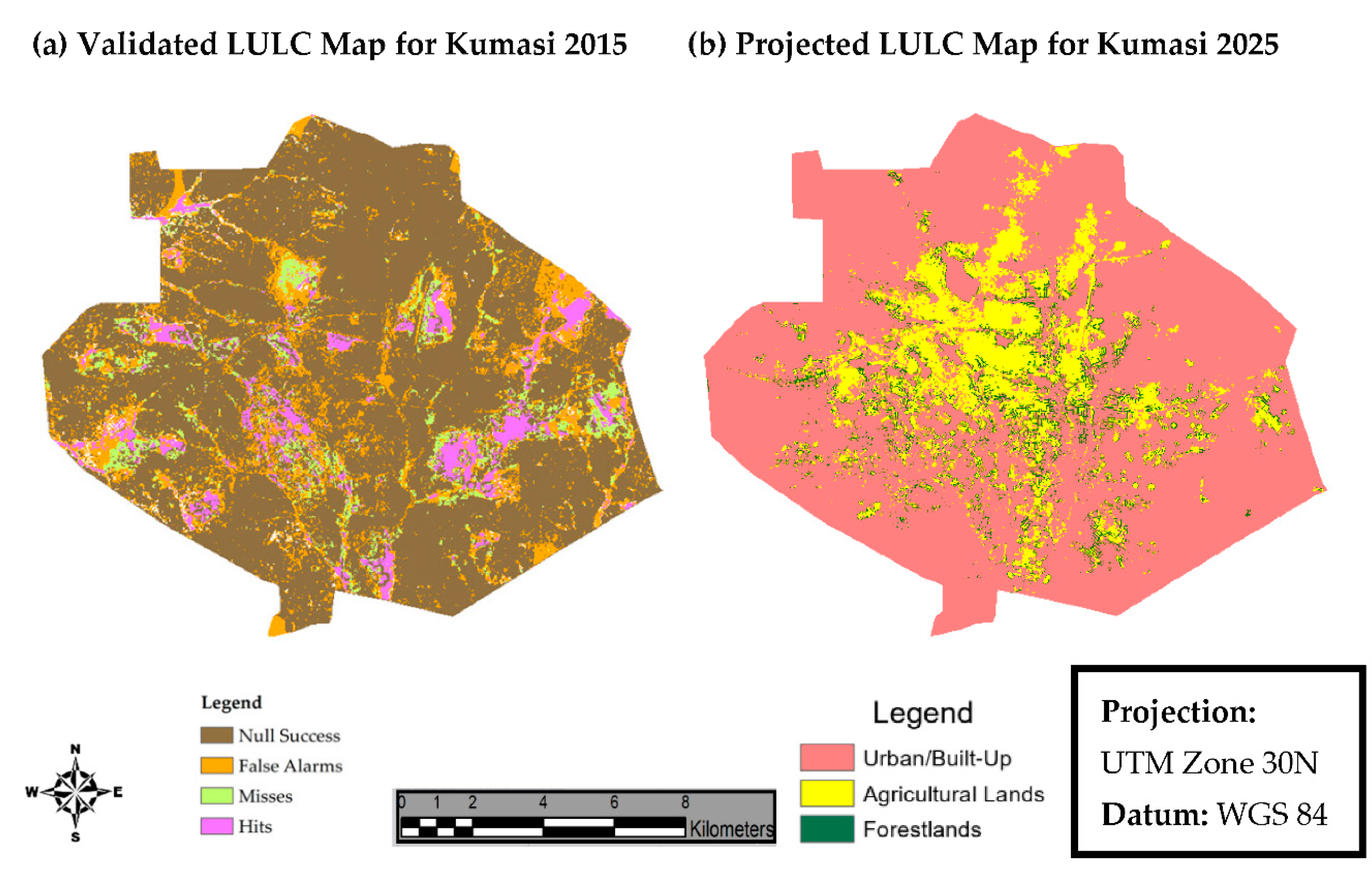
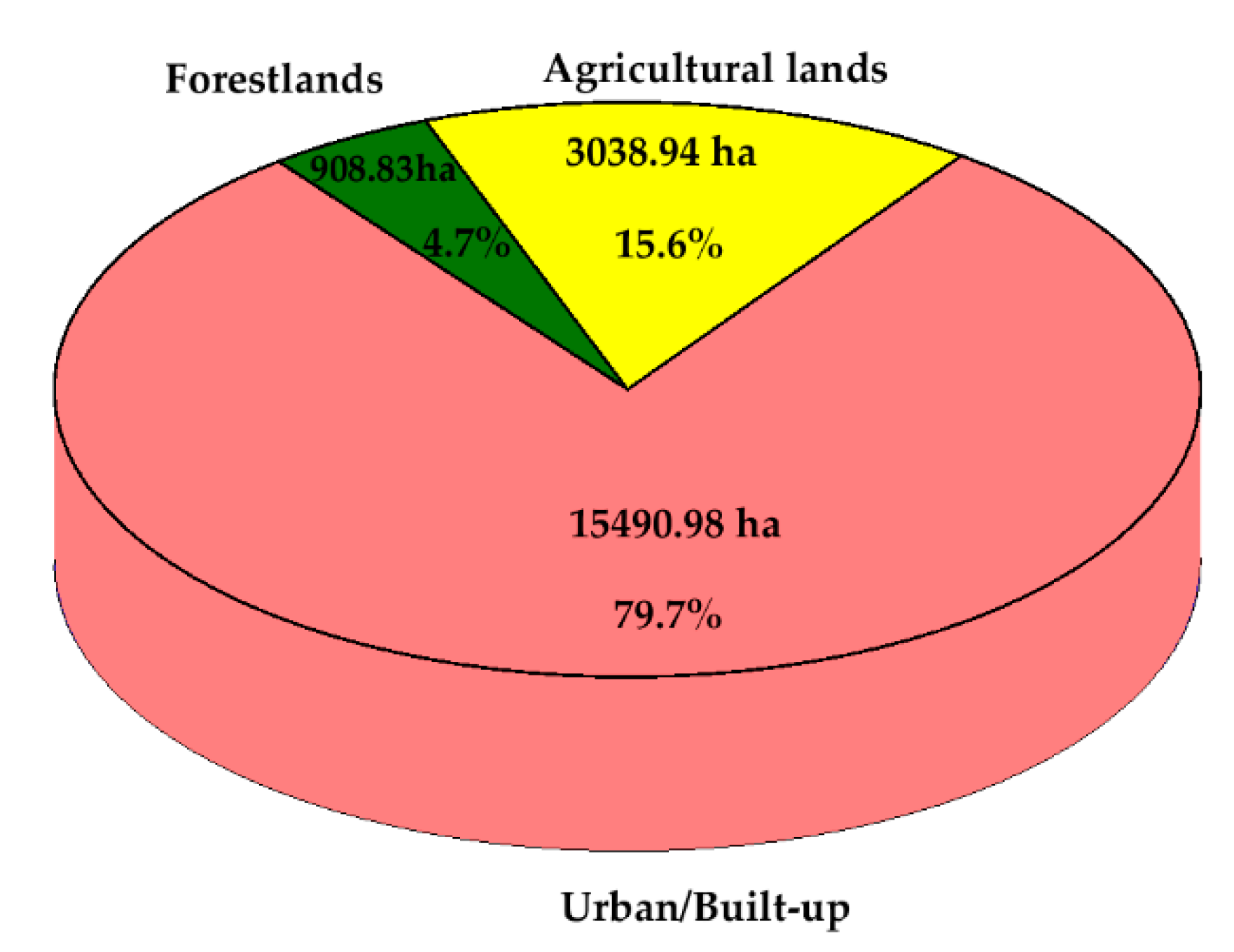

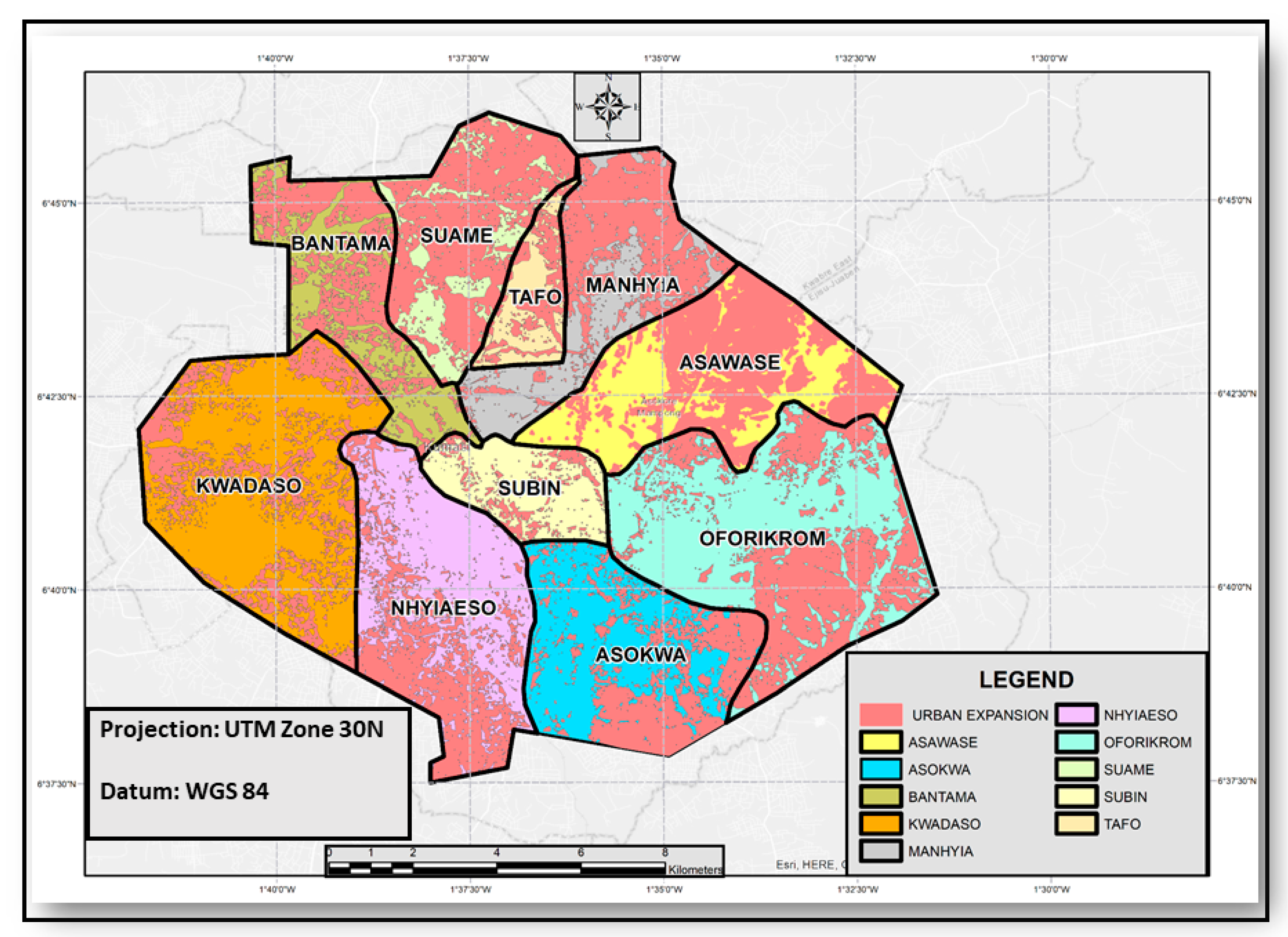

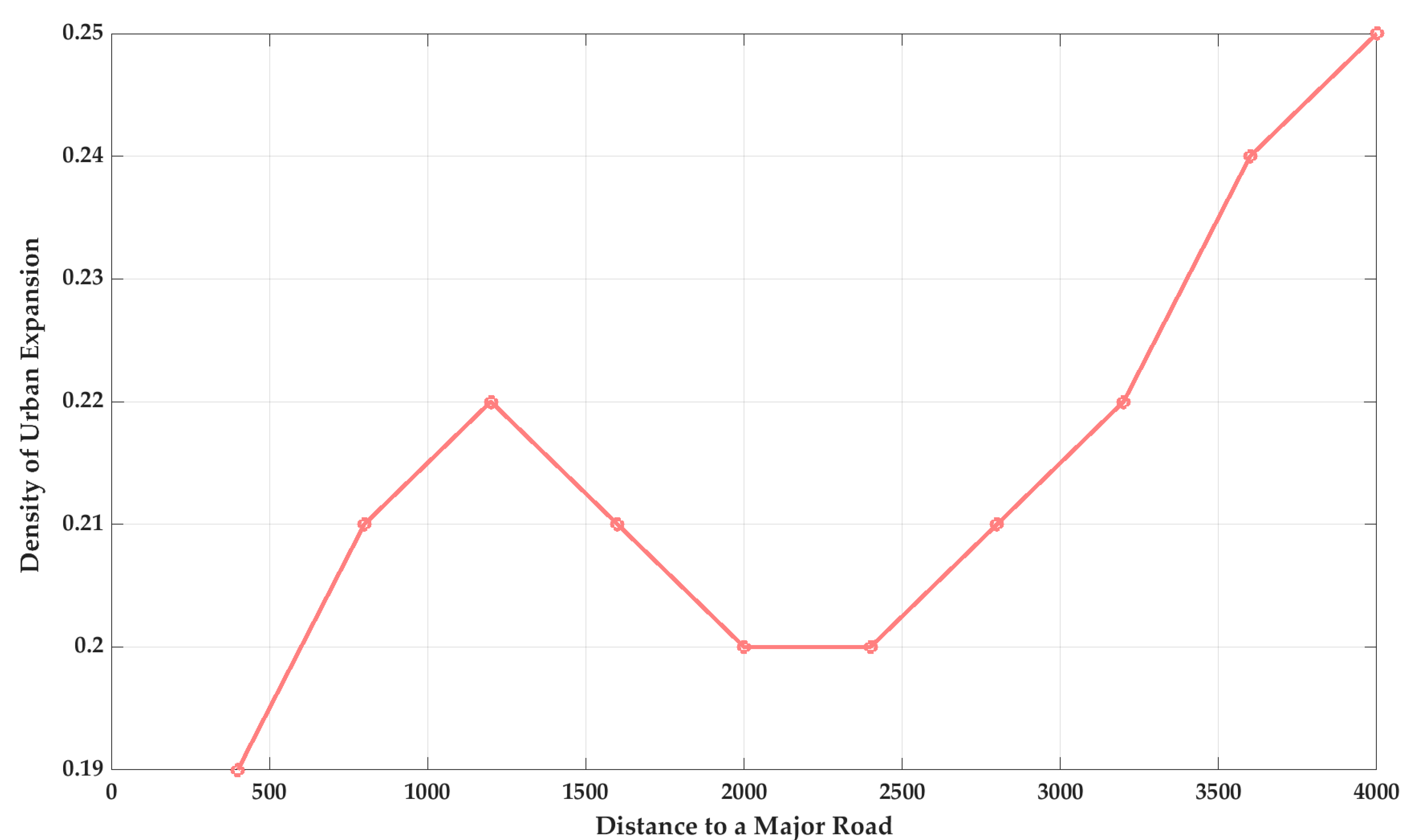
| Satellite | Acquisition Date | Number of Bands | Resolution (m) |
|---|---|---|---|
| (a) Landsat Series | |||
| Thematic Mapper (TM)—5 | 29.12.1986 | 6 | 30 |
| Operational Land Imager (OLI)—8 | 23.12.2013 | 9 | 30/15 |
| Operational Land Imager (OLI)—8 | 11.01.2015 | 9 | 30/15 |
| (b) Advanced Spaceborne Thermal Emission and Reflection Radiometer (ASTER) Global Digital Elevation Model (GDEM) | October 2011 | 1 arc second approximately 30 m |
| LULC Category | Description | |
|---|---|---|
| Urban/Built-up Areas | Residential | Commercial |
| Industrial | Power and communications facilities | |
| Institutions | Highways and Transportation | |
| Lands with exposed soil surface | ||
| Agricultural Lands | Cropland | Pasture |
| Horticultural Areas | ||
| Forestlands | Mixed Forestlands: short canopy trees of about 5–10 m high with a thin occurrence of some emergent trees | |
| LULC Categories | 1986 | 2013 | 2015 | |||
|---|---|---|---|---|---|---|
| Area (ha) | Area (%) | Area (ha) | Area (%) | Area (ha) | Area (%) | |
| Urban/built-up | 4622.49 | 23.78 | 13,447.50 | 69.18 | 14,004.60 | 72.05 |
| Agricultural lands | 716.40 | 3.69 | 3292.92 | 16.94 | 3959.01 | 20.37 |
| Forestlands | 14,098.90 | 72.53 | 2697.30 | 13.88 | 1474.11 | 7.58 |
| TOTAL (ca.) | 19,438 | 100 | 19,438 | 100 | 19,438 | 100 |
| Land Use Land Cover Categories | 1986–2013 | 2013–2015 | Annual Rate of Change (%) | |||
|---|---|---|---|---|---|---|
| Area (ha) | Percentage Change (%) | Area (ha) | Percentage Change (%) | 1986–2013 | 2013–2015 | |
| Urban/built-up | 8825.0 | 45.4 | 557.1 | 2.9 | 1.7 | 1.4 |
| Agricultural lands | 2576.5 | 13.3 | 666.1 | 3.4 | 0.5 | 1.7 |
| Forestlands | −11,401.6 | −58.7 | −1223.2 | −6.5 | −2.2 | −3.3 |
| Land Use Land Cover Change | Areal Extent (in Hectares) | |
|---|---|---|
| (1986–2013) | (2013–2015) | |
| No change | 6673.32 | 14,642.90 |
| Agricultural Lands to Urban/built-up | 253.17 | 1304.28 |
| Forestlands to Urban/built-up | 9197.10 | 255.69 |
| Urban/built-up to Agricultural Lands | 457.65 | 1045.08 |
| Forestlands to Agricultural Lands | 2586.87 | 1584.72 |
| Urban/built-up to Forestlands | 200.34 | 80.10 |
| Agricultural Lands to Forestlands | 69.30 | 524.97 |
| Total Area (ca.) | 19,438.00 | 19,438.00 |
| Driving Force | Cramer’s V |
|---|---|
| Distance from roads | 0.270 |
| Distance from Urban | 0.150 |
| Elevation | 0.002 |
| Slope | 0.012 |
| Sub-Metropolitan | 1986 | 2013 | 2015 | |||
|---|---|---|---|---|---|---|
| Urban Extent (ha) | Urban Extent (%) | Urban Extent (ha) | Urban Extent (%) | Urban Extent (ha) | Urban Extent (%) | |
| Asawase | 498.78 | 10.63 | 1397.52 | 10.36 | 1596.33 | 11.45 |
| Asokwa | 729.36 | 15.54 | 1547.64 | 11.47 | 1563.03 | 11.21 |
| Bantama | 286.56 | 6.11 | 1157.84 | 8.58 | 1165.86 | 8.37 |
| Kwadaso | 421.74 | 8.99 | 1666.00 | 12.35 | 1768.65 | 12.69 |
| Manhyia | 583.65 | 12.44 | 1504.80 | 11.16 | 1518.66 | 10.90 |
| Nhyiaeso | 470.79 | 10.03 | 1578.60 | 11.70 | 1580.49 | 11.34 |
| Oforikrom | 500.13 | 10.66 | 2039.59 | 15.12 | 2129.94 | 15.28 |
| Suame | 302.67 | 6.45 | 1395.26 | 10.34 | 1398.33 | 10.03 |
| Subin | 586.26 | 12.50 | 689.22 | 5.11 | 698.16 | 5.00 |
| Tafo | 312.12 | 6.65 | 512.10 | 3.80 | 517.59 | 3.71 |
| TOTAL (ca) | 4692 | 100 | 13,489 | 100 | 13,937 | 100 |
| Buffer (m) | Area of Urban Expansion in Each Buffer (ha) | Total Land Size in Each Buffer (ha) | Percentage Urban (%) |
|---|---|---|---|
| 400 | 153.30 | 816.28 | 18.78 |
| 800 | 368.62 | 1721.93 | 21.41 |
| 1200 | 606.58 | 2524.41 | 24.03 |
| 1600 | 817.71 | 3834.06 | 21.33 |
| 2000 | 1041.62 | 5040.65 | 20.66 |
| 2400 | 1328.26 | 6347.90 | 20.92 |
| 2800 | 1634.95 | 7755.11 | 21.08 |
| 3200 | 2025.79 | 9262.61 | 21.87 |
| 3600 | 2574.46 | 10,870.33 | 23.68 |
| 4000 | 3086.23 | 12,578.35 | 24.54 |
| Buffer (m) | Density of Urban Expansion |
|---|---|
| 400 | 0.19 |
| 800 | 0.21 |
| 1200 | 0.22 |
| 1600 | 0.21 |
| 2000 | 0.20 |
| 2400 | 0.20 |
| 2800 | 0.21 |
| 3200 | 0.22 |
| 3600 | 0.24 |
| 4000 | 0.25 |
Publisher’s Note: MDPI stays neutral with regard to jurisdictional claims in published maps and institutional affiliations. |
© 2021 by the authors. Licensee MDPI, Basel, Switzerland. This article is an open access article distributed under the terms and conditions of the Creative Commons Attribution (CC BY) license (http://creativecommons.org/licenses/by/4.0/).
Share and Cite
Frimpong, B.F.; Molkenthin, F. Tracking Urban Expansion Using Random Forests for the Classification of Landsat Imagery (1986–2015) and Predicting Urban/Built-Up Areas for 2025: A Study of the Kumasi Metropolis, Ghana. Land 2021, 10, 44. https://doi.org/10.3390/land10010044
Frimpong BF, Molkenthin F. Tracking Urban Expansion Using Random Forests for the Classification of Landsat Imagery (1986–2015) and Predicting Urban/Built-Up Areas for 2025: A Study of the Kumasi Metropolis, Ghana. Land. 2021; 10(1):44. https://doi.org/10.3390/land10010044
Chicago/Turabian StyleFrimpong, Bernard Fosu, and Frank Molkenthin. 2021. "Tracking Urban Expansion Using Random Forests for the Classification of Landsat Imagery (1986–2015) and Predicting Urban/Built-Up Areas for 2025: A Study of the Kumasi Metropolis, Ghana" Land 10, no. 1: 44. https://doi.org/10.3390/land10010044
APA StyleFrimpong, B. F., & Molkenthin, F. (2021). Tracking Urban Expansion Using Random Forests for the Classification of Landsat Imagery (1986–2015) and Predicting Urban/Built-Up Areas for 2025: A Study of the Kumasi Metropolis, Ghana. Land, 10(1), 44. https://doi.org/10.3390/land10010044





